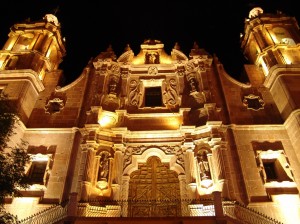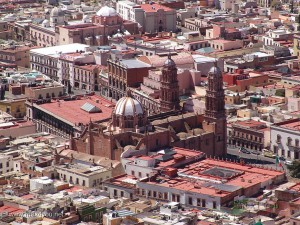 Zacatecas, which name means place where the grass is plentiful, was founded in 1546 and was originally named Mines of Zacatecas. Its mineral wealth gave strong revenue to the Spanish Crown, which made possible that this city receive the title of City of Our Lady of Zacatecas. This colonial city is located in the north central region of the Mexican Republic being one of the most beautiful cities in Mexico, thanks to its historical and architectural wealth was declared Cultural Patrimony of Humanity by UNESCO. In a walk through its narrow streets, alleyways and squares, the tourist will find a number of religious, civic and cultural buildings with a great beauty, tourist can also enjoy a trip on a the cable car. Zacatecas was one of the most important mining sites in the country, in fact, it houses “EL Eden” one of the main touristic mines which can be visited.
Zacatecas, which name means place where the grass is plentiful, was founded in 1546 and was originally named Mines of Zacatecas. Its mineral wealth gave strong revenue to the Spanish Crown, which made possible that this city receive the title of City of Our Lady of Zacatecas. This colonial city is located in the north central region of the Mexican Republic being one of the most beautiful cities in Mexico, thanks to its historical and architectural wealth was declared Cultural Patrimony of Humanity by UNESCO. In a walk through its narrow streets, alleyways and squares, the tourist will find a number of religious, civic and cultural buildings with a great beauty, tourist can also enjoy a trip on a the cable car. Zacatecas was one of the most important mining sites in the country, in fact, it houses “EL Eden” one of the main touristic mines which can be visited.
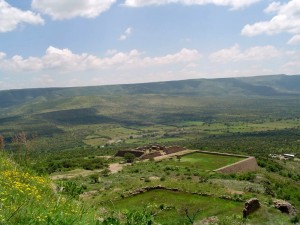 The archaeological site of La Quemada, also known as Chicomoztoc, is located in the southeast of the city of Zacatecas. It is a mythical place where the Aztecs went on his pilgrimage to the center of what today is Mexico. The occupation took place between 800 and 1200 a. C.; its buildings were constructed with stone material on artificial terraces on the slope of a hill. The most prominent buildings are the Citadel, the Hall of Columns, the ball game field, The Votive Pyramid, the palace and the barracks. The site has two complementary parts, on one hand is an imposing fortress and on the other, a walled hill with huge buttresses. Perhaps this defensiveness became more pronounced in recent times prior to abandonment. La Quemada also served as temporary shelter for villagers who occupied the valley. There are many secrets and stories that this site still keeps, as it has only been explored the five percent of the area.
The archaeological site of La Quemada, also known as Chicomoztoc, is located in the southeast of the city of Zacatecas. It is a mythical place where the Aztecs went on his pilgrimage to the center of what today is Mexico. The occupation took place between 800 and 1200 a. C.; its buildings were constructed with stone material on artificial terraces on the slope of a hill. The most prominent buildings are the Citadel, the Hall of Columns, the ball game field, The Votive Pyramid, the palace and the barracks. The site has two complementary parts, on one hand is an imposing fortress and on the other, a walled hill with huge buttresses. Perhaps this defensiveness became more pronounced in recent times prior to abandonment. La Quemada also served as temporary shelter for villagers who occupied the valley. There are many secrets and stories that this site still keeps, as it has only been explored the five percent of the area.
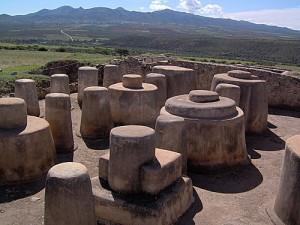 Altavista is located in the northwest of Zacatecas, it was a ceremonial center designed and built with precise guidelines of the Chapin hill, which is situated 7 km southwest of the ceremonial center; there it was found two petroglyphs similar to those discovered near Teotihuacan, from which is projected on the summer solstice, an alignment with the sun. The archaeological site consists of a Hall of Columns, the Pyramid of the Sun, the Labyrinth and the Temple of the Skulls, where it was found a concentration of human bones. It has been shown that the extension of this corridor and the peak of hill Picacho are aligned to the equinox sunrise, so when the sun appears over the horizon, behind the hill, it illuminates the Labyrinth with a direct light beam, by what is called “solar path”.
Altavista is located in the northwest of Zacatecas, it was a ceremonial center designed and built with precise guidelines of the Chapin hill, which is situated 7 km southwest of the ceremonial center; there it was found two petroglyphs similar to those discovered near Teotihuacan, from which is projected on the summer solstice, an alignment with the sun. The archaeological site consists of a Hall of Columns, the Pyramid of the Sun, the Labyrinth and the Temple of the Skulls, where it was found a concentration of human bones. It has been shown that the extension of this corridor and the peak of hill Picacho are aligned to the equinox sunrise, so when the sun appears over the horizon, behind the hill, it illuminates the Labyrinth with a direct light beam, by what is called “solar path”.
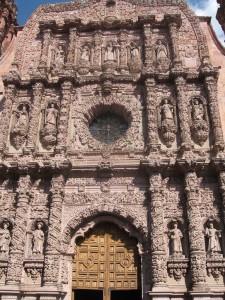 Zacatecas is one of three most important Colonial Cities in the Country, along with Oaxaca and Puebla. It has a wealth of architectural, starting with the beautiful cathedral; its main attraction is the extraordinary facade of three parts carved in pink stone, considered the masterpiece of baroque architecture in Mexico. The construction of this monument started in 1729 and it was not concluded until 1904. In 1862 he became cathedral being the seat of the diocese of Zacatecas, and in 1959 it was elevated to the range of Cathedral-Basilica. Its construction is rooted in a Latin cross plan and consists of three naves with their facades, which ornamentation resembles a huge stone altar where it is shown the history of Christianity.
Zacatecas is one of three most important Colonial Cities in the Country, along with Oaxaca and Puebla. It has a wealth of architectural, starting with the beautiful cathedral; its main attraction is the extraordinary facade of three parts carved in pink stone, considered the masterpiece of baroque architecture in Mexico. The construction of this monument started in 1729 and it was not concluded until 1904. In 1862 he became cathedral being the seat of the diocese of Zacatecas, and in 1959 it was elevated to the range of Cathedral-Basilica. Its construction is rooted in a Latin cross plan and consists of three naves with their facades, which ornamentation resembles a huge stone altar where it is shown the history of Christianity.
Another important sign of architecture in Zacatecas is the Church of Santo Domingo that was founded by the Jesuits in the mid-sixteenth century and is the most important temple after the cathedral. While this was notable for its facade, Santo Domingo does it for its inside, where are kept the eight better baroque altarpieces of the city, one of the most beautiful is dedicated to the Virgin of Guadalupe.
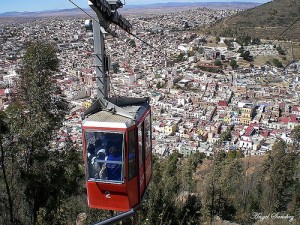 Thanks to the geographical wealth and natural resources tourists can perform a variety of outdoor activities such as hiking; walking or rappel, with beautiful scenery, good conditions of soil and rock formations, the environment become perfect for the ultimate adventures and great challenges. The Cerro de Oreganos is ideal for hiking, offering five different routes with rock formations by volcanic and tectonic activity. In the Sierra de Cardos there are huge cylindrical and rectangular columns and flat walls with different degrees of difficulty to practice rappelling. The tourist can reach the Cerro de la Bufa by cable car from the Cerro del Grillo making a journey of approximately 650 meters in 10 minutes is possible to admire and enjoy a forested landscape and a spectacular view of the city.
Thanks to the geographical wealth and natural resources tourists can perform a variety of outdoor activities such as hiking; walking or rappel, with beautiful scenery, good conditions of soil and rock formations, the environment become perfect for the ultimate adventures and great challenges. The Cerro de Oreganos is ideal for hiking, offering five different routes with rock formations by volcanic and tectonic activity. In the Sierra de Cardos there are huge cylindrical and rectangular columns and flat walls with different degrees of difficulty to practice rappelling. The tourist can reach the Cerro de la Bufa by cable car from the Cerro del Grillo making a journey of approximately 650 meters in 10 minutes is possible to admire and enjoy a forested landscape and a spectacular view of the city.

